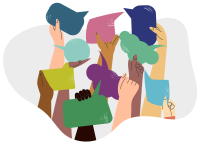Search
There are 5 results.
Category
Tag
Tag
All (50)
Active Learning (3)
Annotated Bibliography (1)
Assessments (1)
Asynchrony (2)
Authentic Activities (3)
Backwards Design (2)
Canvas (1)
Case Studies (1)
Collaboration (1)
Communication (2)
Community (3)
Competency-Based Education (4)
Content Creation (8)
Copyright (2)
Course Maintenance (1)
Course Materials (5)
Course Preparation (6)
Discussions (1)
Diversity (1)
Equity (1)
Faculty Support (1)
Feedback (5)
Formative Assessments (7)
Game-Based Learning (2)
Gamification (1)
Generative AI (1)
Group Work (2)
Inclusion (2)
Infographics (1)
Learning Objectives (3)
Multimodality (3)
Presentations (1)
Representation (1)
Rubrics (1)
Scaffolding (1)
Synchrony (2)
Third-Party Tools (1)
Universal Design for Learning (UDL) (3)
Video (4)
Visual Design (1)
Workforce Development (1)
Written Assignments (1)
Leveraging Podcasts in Online Higher Education
Podcasts are digital audio that you can download or stream onto a computer or mobile device. They are convenient, portable, reusable, and do not require particularly high-tech devices or connections. They are also popular. According to a 2022 Infinite Dial survey, "Seventy-three percent of the U.S. 12+ population (an estimated 209 million people) have listened to online audio in the last month, up from 68% in 2021" (Edison Research, 2022). While podcast use declined slightly in 2022, returning to pre-pandemic levels, the medium is still burgeoning, with plenty of room for further growth.
Inclusive Citation
Inclusive citation practices can empower educators to cultivate equity, enrich academic discourse, and create welcoming learning environments. By prioritizing diverse perspectives and ensuring the representation of underrepresented voices, instructors can address systemic inequities in scholarship and amplify marginalized contributions. Such efforts not only deepen students’ critical engagement with course materials but also foster a sense of belonging, preparing them to thoughtfully navigate an increasingly interconnected world.
Developing Instructional Materials
Once you have defined the learning objectives for your course, you can begin to develop assessments to ensure students achieve those objectives. Once you have created assessments, you can begin to develop materials to ensure students succeed on those assessments. This backward design process—which moves from objectives to assessments and finally to materials—is known as learning-centered instruction, and it directs every course task toward the development of certain skills and competencies. This piece focuses on the third stage of this process, the development of high-quality instructional materials, beginning with the idea that robust and engaging online courses contain a mix of created and curated content. Below, you will find guidelines for creating and curating instructional materials to help you achieve the optimal balance for your course.
Inclusive Texts
Today’s student population is diverse and includes marginalized groups that have historically been excluded from mainstream education (Ladson-Billings, 2013). In 2021, students of color comprised upwards of 40% of the 15.4 million undergraduates enrolled in U.S. colleges and universities (Nam, 2024; National Center for Education Statistics, 2023). Ladson-Billings (2013), whose work centers on culturally relevant pedagogy, argues that diverse students require inclusive learning to succeed. “[These students] do not fit neatly into the rigid categories of race, class, gender, or national origin” upon which hierarchies of the past have been built (p. 5), so authentic representation of diversity in higher education is critical. Adrienne Keene, an assistant professor of American Studies at Brown University, writes that instructors can do their part to support underrepresented students by being honest about their own bias and blind spots, critiquing their course materials, and integrating meaningful representations of diversity into the curriculum (Keene, 2015).





